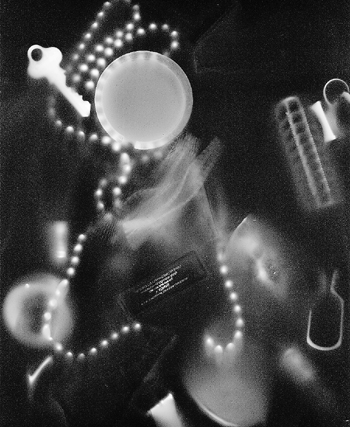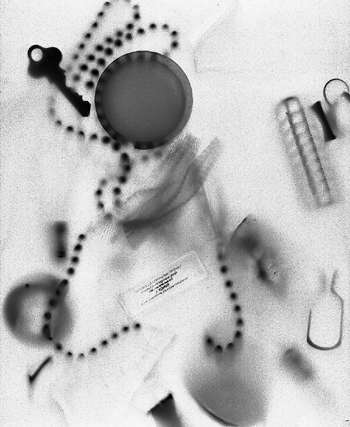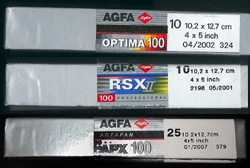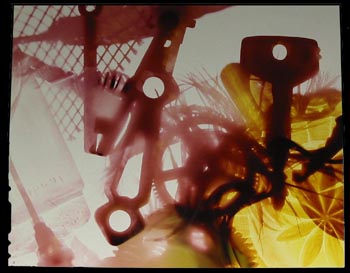While most photograms are made with
standard black and white photographic paper, the Photogram is a process
that lends itself to experimenting and in terms of materials, the
limiting factor is only one's imagination.
Film:
While images can be made on any type of film, film format or size
is an issue when making photograms. Photograms can be made on lengths
of 35mm or 120 roll film but the width of the film is a limiting factor.
Sheet film, say 4x5 works well and then the processed negative can
be enlarged up to any size in the usual manner. 8"x10" sheet
film offers 4 times the area of 4"x5". Generally, using
film is more difficult in that more care is needed with handling that
the surface is not damaged and at the processing stage. It also requires
more equipment like processing tanks etc.
With most film, because
it is sensitive to all light, it is more difficult if not impossible
to see where and how the objects are placed on the paper. It becomes
a random and tactile experience placing the objects on the paper,
but the objects can be placed on a sheet of glass in the light and
the paper slipped under in darkness for the exposure.
However litho film can
be used to make photograms in the same manner to standard black and
white paper. (Most Litho film can be used in a red safelight)
If the photogram
made onto a piece of film is enlarged on to a piece of black and white
paper the final image would become positive.
Black & White
or Monochromatic Films

A photogram exposed
onto a piece
of 8x10 Black & White Negative film
|

The photogram negative printed into a
sheet of paper from the same sheet of 8x10 negative film
|
Colour
film.
If however transparent
colour positive materials were used i.e.. Ilfochrome or sheet film
like Ektachrome the image can be printed onto negative colour paper
to produce an enlarged colour reversal of the original objects placed
on the film.
However, remember there
are some
other factors that come into play: colour neg paper has an over all
blue cast built in to compensate the tan base or orange colour that
is inherent in a colour neg. Because the red transparent object like
a bottle does not have this there would be a colour shift in the opposite
direction of the tan base which might have to be allowed for by altering
the colour filtration in the enlarger. Putting a clear piece of colour
film with the orange base on it in the neg carrier is also a way of
equalizing this shift.
| Top* Agfa Optima 4x5 colour
neg film
Center* Agfa RSX 4x5 Colour transparency film
Bottom*Agfa APX 4x5 100ASA B&W negative
film
|
 |

Photogram on full length of 120 negative
roll film
Details: Photogram on length of 120 negative roll
film

Photogram on
4X5" Transparency Ekatchrome film
Calculating
Exposure for photograms on Film.
As most film has to be
handled in total darkness and takes sometime to process, it can be
useful to devise a method of calculating an exposure.
I have devised the following
method that works well:
1. Lift the head of the
enlarger to cover the entire base board of the enlarger. (Because
the sheet of film has to be placed in the dark it is wise to make
sure the area where the light falls is large enough.)
2. Set the filtration of
the enlarger to the desire setting, and set the aperture to about
f8.
3. Using a hand held light
meter with the sensor set to read incident light, point the meter
directly towards the light source. You might find this gives a reading
of say EV 3.
4. The time for the exposure
should be read on the scale using an imaginary aperture of f1. ( This
assumes there is no restriction to the light falling on the base board
at all.) We need to set the sensitivity of the film. So with an Ev
of 3 and 100 ISO Film we would have a shutter speed of 1/8 sec. or
0.125 on the enlarger timer.
5. However, because of
the nature of what light meters read, transposing this reading to
an exposure time would produce an image with the darkest tone at mid
grey, and not give a dense black.
5. Applying the zone system,
to give a maximum black, the reading would have to be shifted back
by about 4 stops. So 1 extra stop would be 0.25 sec, 2 stops would
be 0.5, 3 stops would be 1.0 seconds, 4 stops would be 2 seconds.
So using the enlarger with
the aperture set where the light meter reading was taken the exposure
would be about 2 seconds.
Enlarged prints can be
made from photogram negatives.